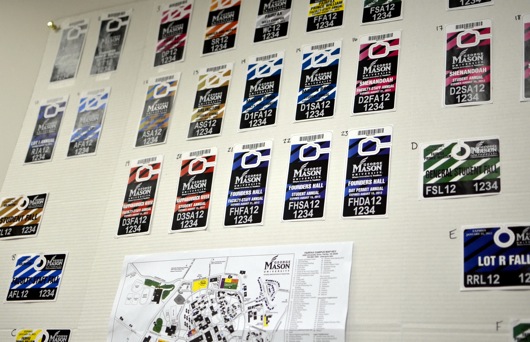Parking director says zoned permits will help with frustration, traffic [Q & A]

Current parking permits for all three Mason campuses hang on a wall of Parking and Transportation's office. (Jake McLernon)
Connect2Mason caught up with Josh Cantor, the director of Parking and Transportation, to talk about the 10-year plan for transportation on the Fairfax Campus that provoked a student “protest” last week.
On the Facebook event page for the protest, organizer and junior economics student Cole Terlesky explained three major problems with the 2011 Transportation Master Plan: the encouragement of the use of public transportation, prioritization of reducing single-occupancy vehicles and increase of permit costs.
About 100 signatures and emails gathered during the event, according to Terlesky in a Facebook message Wednesday.
Cantor responded to many of the claims on the event’s page and in its comments as Gmu Parking Transportation. To better explain some of the bigger questions, we spoke to Cantor and have included excerpts from the conversation below.
Why do permits cost what they do?
JC: Permit fees have actually been held lower than they need to be. Parking & Transportation is a self-funded auxiliary, meaning it receives neither tuition dollars nor general funds from the state budget. All expenses must be covered by self-generated revenue. Expenses include around $6 million annually in debt service on past construction, $3 million in operations, maintenance, projects, and about $3.3 million in transportation ($2.5 million on Mason Shuttles plus $540,000 annual subsidy to City of Fairfax so students and employees can ride the CUE bus for free).
We receive around $60 per student in student fees to help offset transportation costs. The rest is paid for by permit revenue, visitor and event revenue and citation revenue, [which is] only about 8 percent of the budget.
Why are they going up?
JC: As expenses for operations and debt services increases, fees have to increase to generate more revenue. We are continuing to look for ways to run a more efficient operation but also increase services to meet existing demand.
What's the next change students will see in how parking works?
JC: P&T intends to keep implementing the transition to a zoned system, but no decisions have been made yet on what lots will become zoned next year. The other big changes which are possible for next year are related to the West Campus Connector construction that could go through the PV and West Campus lots.
What's the thought-process behind the switch to zone-based permits?
JC: It really provides a solution to two issues that have been consistently identified as the biggest concerns: 1) frustration of not knowing where to find a parking space with a general lot permit and 2) dealing with traffic around campus. With a zoned system, cars will park in one lot and thus drastically reduce traffic.
Another advantage will be greater customer choice as each lot or zoned permit may be priced differently. I use the analogy of buying a concert ticket where you can pay a lot for front row or less to park in the nose bleeds. Lots like A could be premium lots because they are in high demand and be priced higher while lots like K or the Field House lots could be cheaper.
How will the traffic flow work when this plan is implemented?
JC: Projects like the West Campus Connector and the widening next summer of Roanoke River Rd will improve access on and off campus. As we have less people drive alone to campus, traffic will be reduced. The goal of the master plan is to reduce drive alone trips – single occupancy vehicles – by 10 percent by 2020.
